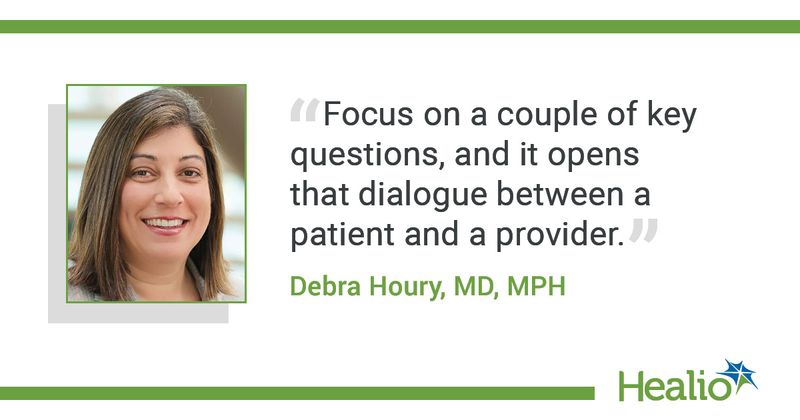CDC: Health-related social needs negatively impact access to mammography screening
Click Here to Manage Email Alerts
Key takeaways:
- Women with vs. without health-related social needs were less likely to undergo routine mammography screening.
- Risk assessment and patient referral to screening services may improve mammography rates.
Only 30% of women with health-related social needs underwent mammography screening for breast cancer in the previous 2 years, according to a newly released CDC Vital Signs report.
The CDC held a media briefing to discuss how health-related social needs may prevent women from undergoing recommended mammography screening and how providers can help ensure women get breast cancer screening. Health-related social needs can include feeling socially isolated, job loss, lack of reliable transportation, food or housing insecurity and cost to access health care.

The U.S. Preventive Services Task Force recommends that women aged 50 to 74 years at average risk for breast cancer undergo a mammogram every 2 years to screen for breast cancer.
“More than 40,000 women die from breast cancer each year in the United States, and while death rates from breast cancer have decreased over time, rates remain high in some groups, such as Black women and women who have low income,” Debra Houry, MD, MPH, chief medical officer and deputy director for program and science at the CDC, said during the briefing. “Routine screening mammograms can help detect breast cancer early when it is easier to treat, and it’s been shown to reduce breast cancer deaths by 22%. Yet, 2022 CDC data show that only about three in four women were up to date with their mammogram as recommended.”
Vital Signs report
For the report, the CDC analyzed data from women aged 40 to 75 years who responded to the 2022 Behavioral Risk Factor Surveillance System to assess associations between mammograms and health-related social needs. More than 83% of women aged 50 to 74 years with no health-related social needs underwent a mammogram in the previous 2 years compared with 66% of counterparts with three or more health-related social needs.
In addition, the report showed state-level differences in being up-to-date with mammograms with more than 85% of women aged 50 to 74 years undergoing a mammogram in the past 2 years in Rhode Island compared with 64% of counterparts in Wyoming. Researchers observed differences in mammography rates based on race and ethnicity with Black women having the highest rate of up-to-date screening at ages 40 to 49 years (65.2%) and at ages 50 to 74 years (82.9%) compared with counterparts of other races and ethnicities. Socioeconomic factors were also associated with mammogram uptake: higher education and increasing income were associated with increased use of mammograms.
The greatest challenge to undergoing mammography screening was the cost of accessing health care, according to Capt. Jacqueline Miller, MD, FACS, first author of the Vital Signs report and medical director of the National Breast and Cervical Cancer Early Detection Program in the division of cancer prevention and control at the CDC. Women without health insurance, those with low incomes and those without a usual source of health care were less likely to undergo screening.
“Other health-related social needs, such as being dissatisfied with life, feeling socially isolated, experiencing loss, reduced hours at work and lacking reliable transportation, were also strongly associated with not having a mammogram in the past 2 years,” Miller said during the briefing. “The bottom line is women are more likely to receive lifesaving mammograms when their social needs are met.”
Improving mammography rates
Understanding how health-related social needs affect mammography screening may help improve cancer control efforts and reduce breast cancer-related mortality, according to Houry.
Breast and cervical cancer early-detection programs are available across the country through state, tribal and territorial health departments, and providers can refer women with low income or no insurance to a local program for screening services, according to Houry. Houry also noted that community partners can increase the number of organizations providing services to support social needs, including transportation, food assistance and social integration, and health departments can work with these programs to provide health-related social services to make mammography screening access easier for women.
Another way to improve barriers to mammography screening is through providers conducting risk assessment for health-related social needs, Houry said, and the CMS will now reimburse health care providers for such risk assessments.
“I know that physicians are busy in their clinical practice, but a lot of this can be done during intake or on the patient questionnaires that are done and asking questions, such as ‘Do they have access to reliable transportation? Do they have enough to eat?’ and making sure that when you ask those questions, whether it’s the nurse or the physician, that somebody looks at those answers and discusses it with the patient to make sure they’re linked to services,” Houry told Healio during the briefing. “Asking these questions is critically important. Really, this takes a minute if you just focus on a couple of key questions, and it opens that dialogue between a patient and a provider.”
Reference:
- Cost and access are not the only barriers women face in getting lifesaving mammograms. www.cdc.gov/media/releases/2024/s0409-vs-mammography.html. Published April 9, 2024. Accessed April 9, 2024.
